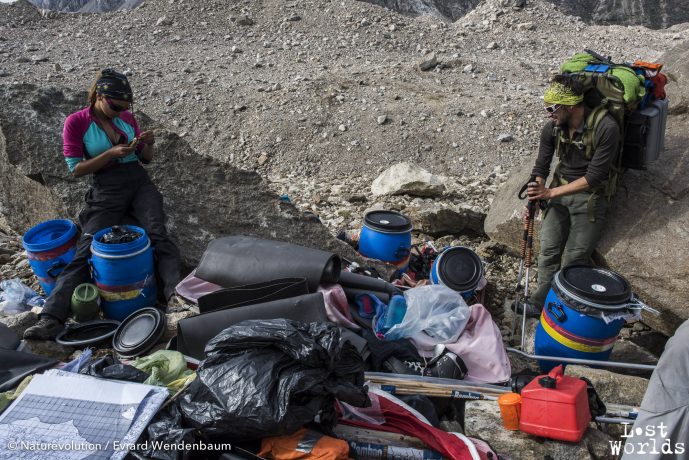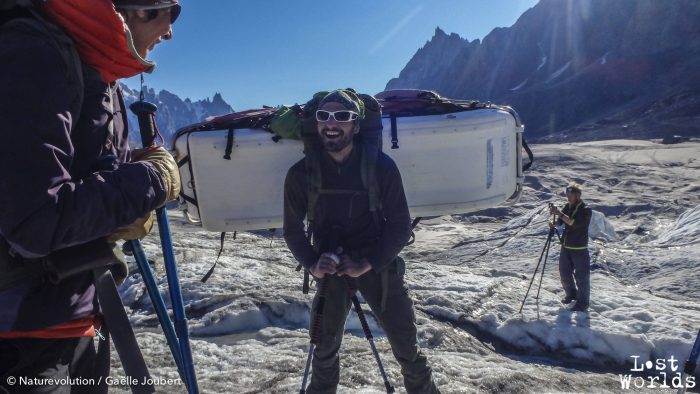In the middle of Renland's glacier, the team stumble into the remains of a former Irish expedition. The excitation of the discovery, quicly turn into a bitter feeling. Too often, expeditions leaves trashes behind, which soiled the fragile lands.
The discovery is unexpected. On our long road to the heart of Edward Bailey glacier, while our eyes are firmly fixed on our tired feet, unusual colors hang our eyes. Between huge brown boulders hide sleds three roses, stubborn traces of an ancient expedition. All around cans. The first few minutes are so exciting: each container is scanned, examined, analyzed. A question is after everyone's lips: what does it contain?
"It's winter expedition of material that contains touring skis, sleds, snow on the bivouac equipment and a bunch of medical equipment. There is even glue to seal skins, a highly flammable and toxic. Not to leave in nature. "
Eric Larose
 Dried fruits are there for five years. Some have not reluctant because of the hungriest.
Dried fruits are there for five years. Some have not reluctant because of the hungriest.The excitement is short lived. Despite a shared sense of invading us. Before our eyes, stretches a hundred kilos of waste, abandoned in the middle of this pristine territory, now defiled. Some clues lead us to guess the origin of this sad landscape: an Irish expedition came in 2011 to spend more than three weeks in Renland. No doubt put in difficulty by extreme conditions, they were forced to abandon some of their equipment on the spot.
 Among the waste found, laminated maps of the territory. And also dried fruits and cereal bars that Gaëlle and Olivier are quick to devour.
Among the waste found, laminated maps of the territory. And also dried fruits and cereal bars that Gaëlle and Olivier are quick to devour.This is not new. For decades, successive expeditions have left behind a floor strewn with waste. This phenomenon, which particularly affects the Himalayas forced the authorities to take drastic measures.
“Generally speaking, the climber comes with a goal. Once he has reached his goal, he has a kind of loss of motivation, fed up, general fatigue, which very often lead to dropouts. In the Himalayas, the government now requires expeditions to bring back exactly the same as when they arrived. »
“Among scientists, it’s exactly the same topo. There are expeditions that have left astronomical quantities of waste, rotten, polluting, on ice caps in Antarctica. This is what annoys me in general in the small world of the mountains: we do our personal trip and once finished, we go home. It's just hopeless. I find it pathetic. »
Evrard Wendenbaum
What consequences can this waste have on the environment in the long term?
"Plastic does not decompose. With UV from the sun, he finally break into small pieces, particles are then carried by the river and end up in the ocean. One day or another, they end up in our plate. »
Eric Larose
A DIFFICULT CHOICE
Quickly, the decision is made: a fire is improvised heart moraine, Waste is burned there in the open. While the flames rise to the sky as our stunned eyes, Evrard fixed bulky sleds, left on the ground. They will be brought back to our return and cans. Evrard and Eric know: this decision entails a new challenge for the team, already exhausted by long portages.
We have to sort, part is left, they burn and part which can be reduced. These are not choices we want to do. It's disappointing. "
Eric Larose
 Anything that cannot reasonably be reused or brought back as is is burned, and the residue is brought back with us.
Anything that cannot reasonably be reused or brought back as is is burned, and the residue is brought back with us. Olivier will carry more than 45 kg to bring back the remains of the expedition.
Olivier will carry more than 45 kg to bring back the remains of the expedition.AND U.S ?
But are we completely exemplary? Say that we have no impact on the environment would be a nonsense. Sixteen people on this mission, traveling by plane from France and Renland is a day boat. As for food, "we try to eat organic or local, and be thrifty. But not always you get there, "admits Evrard.
The importance of individual behavior is fundamental. The rule is first to leave nothing behind, "is the least of it," says Evrard. And to collect waste found its way, as Sydkap.
 In Sydkap, the expedition spends the afternoon collecting and burning waste.
In Sydkap, the expedition spends the afternoon collecting and burning waste."The impact is obvious. The idea is to offset the one hand highlighting the site and trying to protect the other hand thanks to actions in different corners of the planet. If we wanted to have no impact, it would do nothing and live like a hermit. We can not. L'idée est donc d'avoir le moins d'impact possible. »
Evrard Wendenbaum
 The time of spring cleaning to Sydkap.
The time of spring cleaning to Sydkap.









